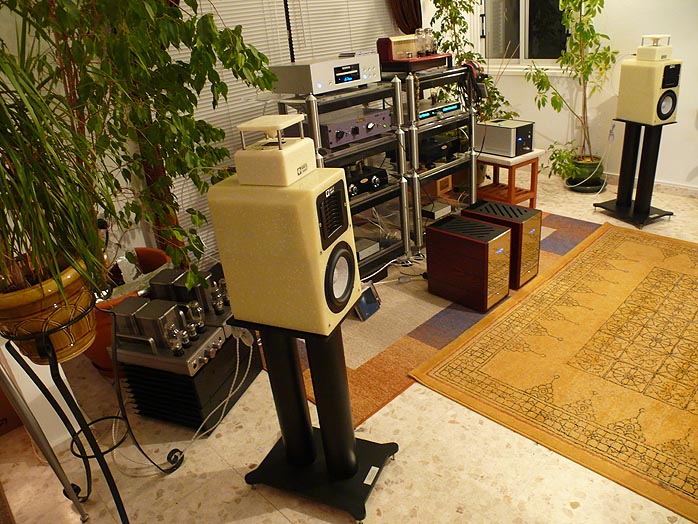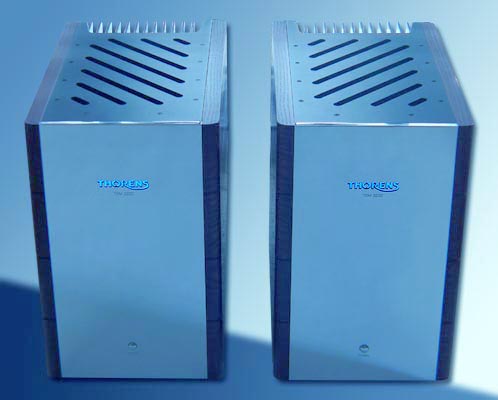|
|
|
|
|
This review page is supported in part by the sponsors whose ad banners are displayed below
|
|
 |
|
Triodes on steroids?
The Butler Audio Monad A100 promised this ambitious concept but to these ears, had too much transistor dominance to deliver. Based on Roy Gregory's HiFi+ review, I expected the same of the Thorens monos. I was wrong. The triodes-on-steroids dream ticket finally arrived. The triode part was tone density and color. As hard as that may be to believe, immediacy went well beyond triodes into super triode heaven and directness pure. Layering and depth were superlative. Ditto for staging fully into the room corners behind and outside the speakers - wicked as sin and over the top superb.
|
|
 |
|
|
This image opens to 2000 x 1500 at 314KB in a new window
|
|
The steroid part involved control as in, grip of steel. This was true across the band and expressed itself in that raw unwavering intense directness compared to which even the best triodes sound indecisive and less than committed. It also expressed itself in superb bass extension and unknown amplitude, the latter demanding I tweak the DeVore Nines which suddenly punched well beyond their weight class (I stuffed one of their ports with a rolled-up sock). On HipHop fare like Daara J's killer Boomerang, the beats were as slamming as can be and dry as dust, completely beyond the purview of power triode damping.
If you add up these qualities, a composite overlay emerged. It combined tube and transistor elements just as the raw ingredients predicted. Yet it included far more thermionic aspects than expected. This was readily demonstrated at low volumes where tubes rule. They always sound fuller and fleshier than transistors which lean out by comparison. Not here. The TEM 3200s out-trioded the glass bottles in the whisper-but-still-gripping stakes to act like super triodes.
|
|
 |
|
The overriding quality that gave away the monolithic transistors in this mix was the constant pressurization of everything. It lacked the looser, fluffier relaxation good triodes invoke. That's the grip of steel control. It never let go. It created an inner tension which some may find stimulating and exciting, others too demanding or even relentless. Think permanently ripped, super-buffed physique with minimal body fat, all muscle and jump and transient reflexes. That was the alter ego which had been grafted onto saturated tube tone and expansive dynamics.
|
|
|
|
The purity of focus and crystallization direct-heated 45s deliver was fully intact but intensified. It's not something ordinary push/pull circuits I've heard deliver. The earlier transfer function graphs for traditional complementary circuits clearly show why. Now I must confess that I deliberately selected a valve preamp (and of those I own, the one with the most exploded bandwidth) to conceptually mimic what I expect Thorens' own TEP 3800 might bring to the party. In Casa Coral Bay, that's Roger Hebert's Wyetech Labs Jade based on the Grounded Grid circuit implemented with three 6SN7s. Front ends were the Alex Peychev NWO 3.0-GO (an Esoteric UX-1 converted to run 20 x 32-bit DACs per channel into a direct-coupled ECC 99 triode output stage) and the Dan Wright tube-fitted ModWright Transporter fed from the Music Vault. In other words, tube man's system.
|
|
 |
|
In that context and still with my fully passive DeVore Nines floorstanders which are nowhere near in need of such power, the Thorens monos betrayed -- if we must use that term -- their transistor muscle with monster control and bass from the underworld, not in tonal bleaching, spatial compaction, treble irritation or other ills one might, rightly or not, expect from semi conductors. But, these amplifiers always sounded loud regardless of what level I played them at. Loud meant full, dynamic, pressurized and intense. Interestingly, switching from the 91dB 8-ohm DeVores to the 85dB 4-ohm Mark & Daniel Maximus Monitor with Omni-Harmonizer, some of that high-pitched inner tension mellowed, as though by outputting more power, the amp stretched its legs and downshifted gears for lower RPMs.
The Maximus Monitor is a colossal but obscure achievement - obscure because its high-value pricing means it'll mostly be driven by affordable muscle amps - if sufficient muscle even. Most owners will leave things under the table. The TEM 3200s proved how the ambitious bass alignment of this synthetic marble speaker with the long-throw underhung mid/woofer is unnatural only relative to expectations, not actual listening. With the extreme control exerted by Blöhbaum's high-current counter-phase circuit, the infamous bass chops of this monitor set new records to not awaken any subwoofer desires even on Mercan Dede's Nefes - all without appearing to be grotesquely overblown in the least.
|
|
 |
|
|
The Woo Audio Model 5 300B amp with current WEs and over the 101dB 16-ohm Zu Audio Presence barely distinguished between the $30,000 NWO 3.0-GO and $4,000 ModWright Transporter in WiFi mode. The TEM 3200s elucidated on the source differences in obvious ways. One of those was treble purity. While the completely rebuilt Esoteric UX-1 made happy ears with the Maximus' optional upfiring ambient air motion transformer at full output, the Transporter needed the -5dB setting or else, the top end exhibited too much hash noise. The single-ended tube amp plainly operated at a lower level of resolution. It imposed its own equalizing action, creating sameness where the far higher resolving power of the Thorens monos effortlessly separated out clean distinctions that were obvious.
|
|
 |
|
 |
|
|
|
This image opens to 2000 x 1500 at 333KB in a new window
|
|
|
Ivette joined me for a listening session where she made an impromptu comment of stark brilliance. The sound of the Mark & Daniels driven by the TEM 3200s reminded her of our long-gone Avantgarde Duos. "These speakers now sound like your horns used to." Exactly. Perfect recall. Like horns distills all of the above into one very poignant ringer of a characterization. Set aside whatever prejudices you might hold about horns (the Cessaros from Germany would change your mind). Focus on the strong points even detractors would agree on: directness, speed and dynamics. Perhaps Ivette should do my reviews, I her home cooking? But I'd poison us both so perhaps, we'll best leave things alone...
|
|
|
|
Triodes on steroids. This is not a forgiving concept. It's ruthlessly revealing of shortcomings elsewhere. If you can float 18Gs for a pair of amps with floating outputs though, you should be able to float appropriate ancillaries. It goes with the territory. The Thorens monos are without question genetically superior amps though they aren't recommended for sub 4-ohm speakers. There's a reasonable limit to what they're happy driving. For arc welding, go to Krell.
Testing up to this point suggested that the high inner tension described relaxed when a speaker load demanded to be controlled and also drew more on the available current. I was thus suspicious that perhaps not sonically but at least gestaltically ( on the participatory feeling level), these power-house amps had to be put to work rather than leisurely idle on a no-work load. Most high-power amps famously lose their lunch on first watt speakers. As it happens, two of my in-house high sensitivity speakers incorporate active bass systems. The floating nature of Blöhbaum's outputs strictly warned against powered subwoofer connections which could introduce a ground reference to then melt the circuits. I thus held off until after Thorens' freelance engineer and the respective speaker designers had shaken hands via e-mail. My instincts had the monos at enthusiastic hello with Zu, at cold shoulders with Rethm whose Lowthers seem averse to the sort of damping the Thorens dish out by design. Many old-style widebanders in fact prefer not a voltage but current source amplifier like First Watt's F1 and F2. Because my Zu Presence review loaner's woofer amps can be driven low-level from a preamp, this kicked off my 1st-watt investigations without concerns for circuit safety. |
|
|
 |
|
|
|
|
 |
|
 |
|
|
|
|
|
|
|
|